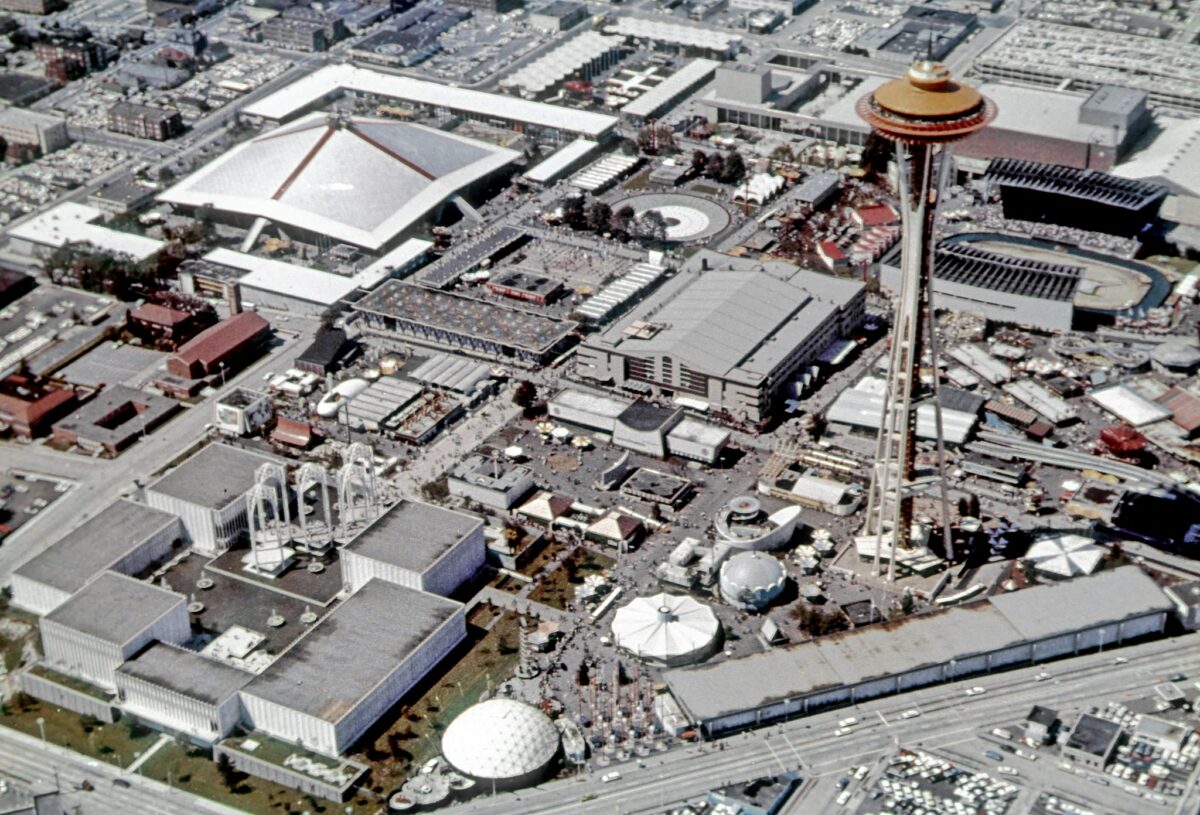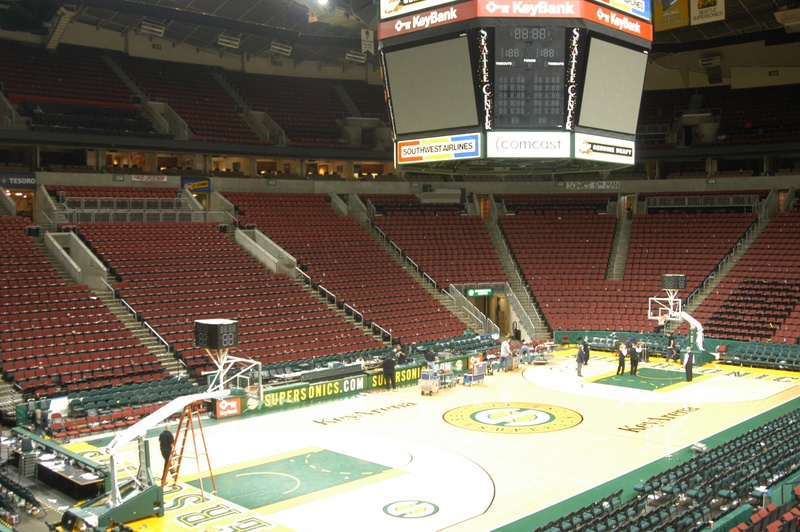The Seattle Kraken are just months from taking the ice as the 32nd NHL franchise. Their home, Climate Pledge Arena at Seattle Center, will not only impress fans as a new hockey venue, but it will also make environmental strides as the first carbon-neutral arena in the world.
However, Climate Pledge Arena is part of a greater evolution of its site, dating back to its origins as the Washington State Coliseum in 1962. For nearly 60 years, what is now Climate Pledge Arena has hosted an array of events, including 30 years of hockey, and has undergone several massive transformations. Below is a history of what will technically be the NHL’s oldest active venue.
Washington State Coliseum — 1962 World’s Fair
In 1962, Seattle hosted the Century 21 Exposition, or World’s Fair, and in preparation, constructed several sights & attractions just north of downtown. The most recognizable structures were the Space Needle and the first iteration of Climate Pledge Arena, the Washington State Pavilion — which was quickly renamed the Washington State Coliseum.

The Coliseum was designed by Paul Thiry, a famous architect of the Pacific Northwest region, whose work includes Seattle’s Frye Art Museum and the Washington State Library in Olympia.
Financed by the state for $4.5 million, the venue evoked a European-inspired modernist design with its hyperbolic-paraboloid roof and exterior glass walls. Up to 100 visitors could board the Bubbleator, a globe-shaped elevator, and ride up 28 feet to view the World of Tomorrow exhibition.
Seattle Center Coliseum — 1964-1995
After the fair, the city purchased the Coliseum from the state and began an 18-month renovation — transforming the venue into a multi-purpose arena renamed the Seattle Center Coliseum.
The Coliseum’s longest tenant was the former Seattle SuperSonics — now the Oklahoma City Thunder — who entered the NBA in 1967. The Sonics occupied the Coliseum over two main stints, 1967-1978 and 1985-2008, and nearly won a championship on their home court. The year after their first Coliseum tenancy ended, the team, now playing home games at the Kingdome, won the 1979 NBA Finals in Landover, Md. against the Washington Bullets.
Before the Sonics, the Coliseum hosted the University of Seattle men’s basketball team and the Western Hockey League (WHL) Seattle Totems. Entertaining crowds as large as 12,250, the Totems played on Seattle’s largest hockey stage to date.
The Totems called the Coliseum home from 1964-1975 and won two Lester Patrick Cups as WHL champions. They swept the Vancouver Canucks 4-0 in 1967 and bested the Portland Buckaroos in five games the following year. However, their most impressive performance came in an exhibition match six years later.
Seattle Totems — The First ‘Miracle on Ice‘
Before the United States completed an unfathomable upset of the Soviet Union at the 1980 Winter Olympics, the Seattle Totems pulled off an equally unprecedented feat inside the Coliseum. They faced off against HC CSKA Moscow, also known as the Red Army, on Jan. 5, 1974, in front of 12,710 fans.
The Red Army had handily defeated the Totems just over a year prior, 9-4, and decided to rest some of their cornerstone players for the rematch — including Alexandr Maltsev of the 1980 Olympic squad and his linemates. Clearly, they underestimated the tenacity of the opposition, as the Totems’ Dave Westner slipped a shot by legendary goaltender Vladislav Tretiak just 94 seconds into the game — the lone tally in the first period.
The Soviets regained themselves and took a 2-1 lead in the second period, riding the talents of Olympians Boris Mikhailov and Valeri Kharlamov. However, the momentum vanished 31 seconds later, as the Totems drew a penalty. Seattle scored on the power play and twice more, all within 97 seconds, to take a 4-2 lead. Don Westbrooke scored in the final minute of the period to extend the lead to 5-2.
Maltsev and his linemates suited up for the third period but could not initially close the deficit, as Seattle potted two more goals to extend their lead to a 7-2 rout. Westbrooke capped off a stunning performance with a third goal at the end of the match, becoming the only North American player to net a hat trick against Tretiak (from ‘The night the Seattle Totems managed their own ‘Miracle on Ice’ against a Russian power,’ The Seattle Times, 11/29/19).
Home of the Thunderbirds — 1989-2008
The Coliseum endured a 14-year period without regular hockey matches but eventually welcomed its next club, the Seattle Thunderbirds of the current WHL, in 1989.
Congratulations to former T-Bird and current @SanJoseSharks Patrick Marleau on establishing a new @NHL record for Games Played tonight! #LetsGoPatrick #LetsGoBirds pic.twitter.com/UPtkhKRGNc
— Seattle Thunderbirds (@SeattleTbirds) April 20, 2021
The venue immediately produced one of the best home-ice advantages in sports, as the Thunderbirds finished 31-4-1 at home their first season. Petr Nedvěd, who produced 717 points over his lengthy NHL career, took home Rookie of the Year honors, among several other accolades awarded to his team. However, Seattle was defeated by the eventual WHL champion Kamloops Blazers in the Conference Final.
In 1992, the Coliseum hosted the Memorial Cup of the Canadian Hockey League. Seattle advanced to the semi-final but were defeated again by the Blazers, who won the Cup.
The Coliseum, now renamed KeyArena, hosted two games in the 1997 WHL Championship for the President’s Cup. Seattle was outmatched, as the Lethbridge Hurricanes swept the series, 4-0. Leading the Thunderbirds that season was none other than 17-year-old Patrick Marleau. Months later, he was drafted second overall by the San Jose Sharks, and nearly 24 years later, broke Gordie Howe’s NHL games played record. The Thunderbirds left KeyArena in 2008 and now play at accesso ShoWare Center in the suburb of Kent.
KeyArena — 1995-2018
By the mid-1980s, the Coliseum began to show signs of aging and spurred Sonics owner Barry Ackerley to pursue alternatives. The NBA had to impose its only rain delay in 1986 when rainwater seeped from the Coliseum roof onto the court.
After considering moving the Sonics out of the Coliseum and potentially to another sports market, Ackerley partnered with the city to renovate the venue. Seating capacity was increased by nearly three thousand to 17,072, and the court was lowered to 35 feet below street level. Completed in 1995, the newest rendition of the Coliseum was named KeyArena at Seattle Center.

A year later, the Sonics reached the NBA Finals but were defeated by Michael Jordan and the Chicago Bulls. They played their last game at KeyArena in 2008 before moving to Oklahoma City.
In 2000, KeyArena welcomed the WNBA Seattle Storm, with the first game drawing 10,840 fans. Four years later, the Storm defeated the Connecticut Sun at KeyArena to bring home Seattle’s first professional sports championship in 25 years. They also won the 2010 WNBA Finals at KeyArena and brought home two more championships in 2018 and 2020.
KeyArena remained a popular venue for teams like the Storm, Seattle University basketball, Rat City Roller Derby, and events like the annual Bumbershoot Arts & Music Festival. In 2017, Seattle.gov estimated annual attendance at 550,000, with over 20 million attendees in the building’s lifetime.
Climate Pledge Arena — 2018-Present
In April 2017, the city of Seattle accepted three bids to redevelop KeyArena under its 1962 roof, negotiating a deal with Oak View Group (OVG) in June. On Dec. 4, 2018, the NHL Board of Governors announced Seattle as the recipient of the 32nd franchise, and the following day, the project broke ground.
On June 25, 2020, the yet-to-be-named Kraken, OVG, and Amazon, who purchased the venue’s naming rights, announced Climate Pledge Arena. As a net-zero carbon facility, the arena will run primarily off solar power, and its ice surface will be assembled with collected rainwater.
The estimated $1 billion project, financed entirely by OVG, includes a seating capacity increase to 17,100 for hockey and 18,100 for basketball. Despite having no NBA tenant, it will host regional matches for the 2023 NCAA Division I Women’s Basketball Tournament, along with first and second-round games during the 2025 NCAA Division I Men’s Basketball Tournament.